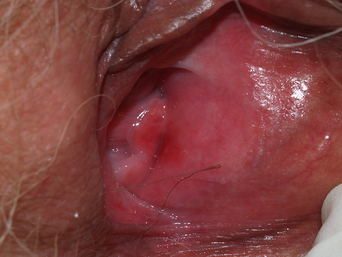CHAPTER 27 Vulvodynia
Vulvodynia is defined as chronic burning, stinging, irritation, soreness, rawness, stabbing, or other painful sensations of the vulva in the absence of any clinical or laboratory abnormalities that could account for the discomfort. Itching is not a typical symptom.
Epidemiology and clinical manifestations
Vulvodynia is an extremely common condition. Several surveys report that approximately 10–16% of women have experienced unexplained chronic vulvar pain at some point in their life, and about 4–7% of women experienced unexplained discomfort at the time of surveys1–3. Vulvodynia occurs in Caucasians and African women at similar rates, and may be increased in women of Hispanic background1. The incidence in Asians is unknown. It generally occurs after the teenage years.
By definition, the physical examination of women with vulvodynia shows no specific cause for pain. Mild erythema is sometimes present, and patients usually indicate the vulvar vestibule as the area of greatest discomfort. Many women, however, experience pain that extends beyond the vestibule at least at times, and some patients report discomfort involving the labia majora and even the perineum and perianal skin.
Vulvodynia has been classified into different subsets depending upon location of pain and the presence of spontaneous pain (unprovoked) versus pain only to touch or irritants (provoked). The significance of these subsets lies in the possibility of different etiologies for different patterns; the importance of standardizing terminology so that research evaluates like populations; and the fact that surgical therapy is only appropriate for very localized forms of vulvodynia. The International Society for the Study of Vulvovaginal Disease has clarified and redefined the classification and terminology of vulvar pain vulvodynia and subsets4. This new classification divides causes of pain into that produced by specific disorders and vulvodynia, and further divides vulvodynia according to location and the presence or absence of pain with touch, friction, pressure, urine, or other usually nonpainful stimuli (Box 27.1).
Box 27.1 Terminology and Classification of Vulvar Pain
Adapted from: Moyal-Barracco, M. and Lynch, P. J. 2003 ISSVD terminology and classification of vulvodynia: a historical perspective. J. Reprod. Med. 2004; 49: 772–777.
From a practical standpoint, patients with vulvodynia most often fall into one of two major patterns. First, and most common, is that of vestibulodynia (formerly called vulvar vestibulitis, vulvar vestibulitis syndrome, vestibular adenitis, and infection of the minor vestibular glands). These patients tend to be premenopausal and report pain with touch in the vestibule, including sexual activity, constricting clothing, tampon use, and bicycle-riding. Nonspecific erythema within the vestibule is sometimes present (Figure 27.1). The other primary pattern is that of generalized vulvodynia, where discomfort is either generalized or migratory, and generally reported to be independent of touch. Unfortunately, few studies carefully characterize patients with vulvodynia sufficiently to validate the separation of two or more subsets, and this author and others do not find these to be easily separable subsets5,6. Most patients exhibit symptoms that exist on a spectrum, with considerable overlap, suggesting that vestibulodynia and generalized vulvodynia are variants of the same process.
Often, patients report comorbid conditions, including interstitial cystitis, chronic constipation or irritable bowel syndrome, fibromyalgia, headaches, temporomandibular joint syndrome, low-back pain, depression, anxiety, premenstrual syndrome, sleep disorders, multiple medication “allergies,” and low energy levels7.
Diagnosis and differential diagnosis
Specific neuropathic pain syndromes mimic vulvodynia: diabetic neuropathy, postherpetic neuralgia (which occurs following herpes zoster virus infection rather than herpes simplex virus infection); and pudendal neuralgia8. At times, nerve root compression from a protruding disk, or central nervous system diseases such as multiple sclerosis, cause pain, but these are generally not localized to the vulva.
The diagnosis of vulvodynia can be made largely by history, with the majority of women self-reporting chronic burning or irritation ultimately receiving a diagnosis of vulvodynia9. However, in order to avoid missing the occasional patient with an easily correctable cause of pain, these conditions must be ruled in or out by a careful physical examination, routine vaginal cultures, and the careful evaluation of a wet amount of vaginal secretions for both infectious organisms and inflammation. Neuropathic pain syndromes can be more difficult to rule out, although a history and physical examination to include a local neurologic examination usually help to identify specific, definable neurologic causes of pain.
Pathogenesis
The pathogenesis of vulvodynia appears to be multifactorial. Vulvodynia is a symptom rather than a disease, so that different factors may operate in different patients. Factors include neurologic abnormalities, pelvic floor dysfunction, irritant contact dermatitis, inadequate estrogen effects, and psychosexual factors (Box 27.2).










